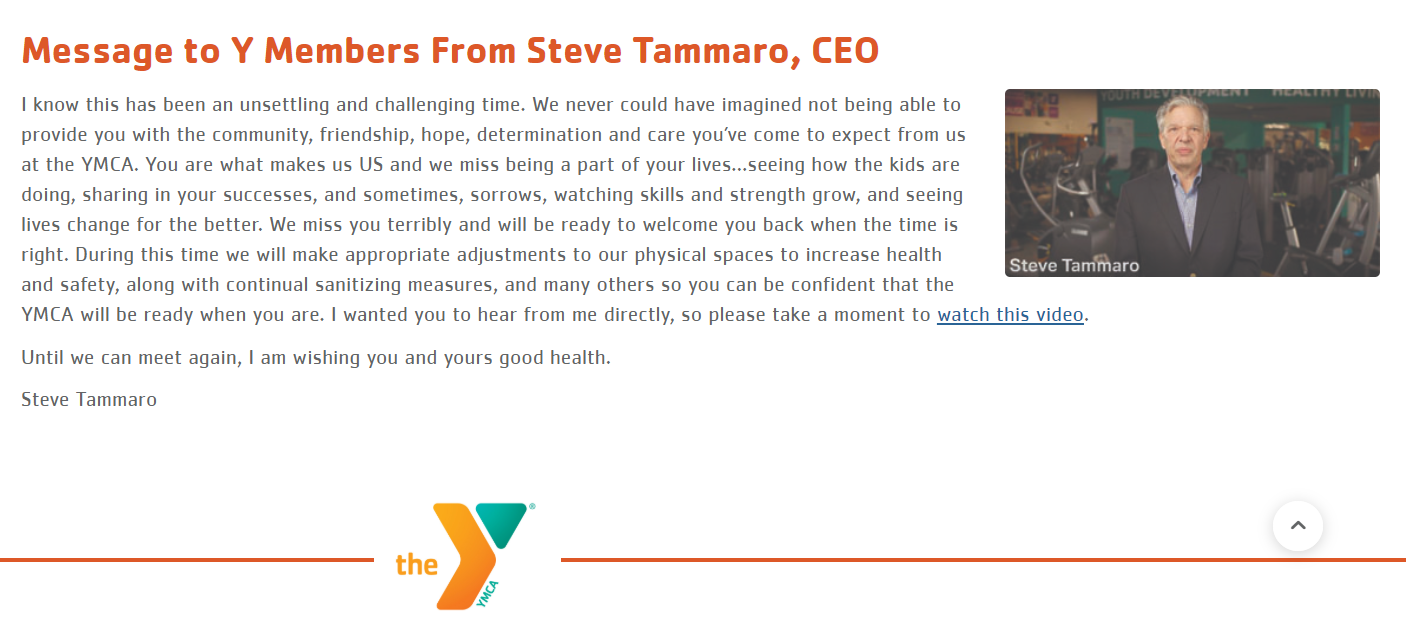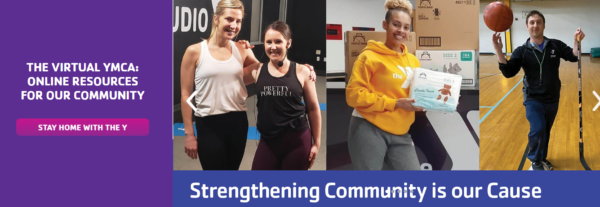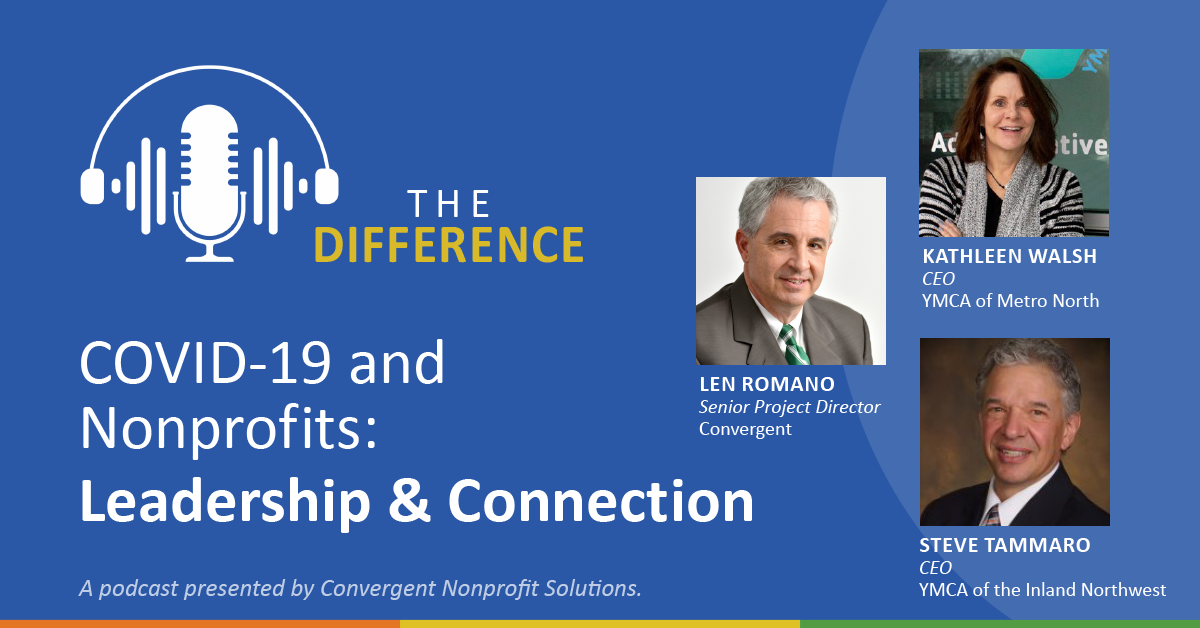I was recently joined on our podcast by YMCA professionals Kathleen Walsh and Steve Tammaro. Kathleen is the CEO of the YMCA of Metro North, and Steve is CEO of the YMCA of the Inland Northwest. These two are on opposite sides of the country but the way they have been dealing with and leading their organizations in adapting to the COVID-19 pandemic has been so impressive to me.
Here is just a bit of our conversation. Please feel free to listen to the podcast for all of it. I felt like talking to these two professionals was a Master’s class in leadership and connection. I hope you agree!
Let’s start by talking leadership. Everyone is looking to you for decisions and solutions. What are some of the first things you did and some of the most important things you did when this crisis hit?
Kathleen: We have just under 800 employees with 160 of these at full-time in eight different locations. How did I handle it? I’m new at this. I’ve been doing it for about one year. There was no training about how to handle a pandemic. There was no chapter on it in any of my leadership books. It was a lot of learning as we go. But I communicated. I was super transparent. I asked my team for their input, and we built a plan together.
It’s funny, you know, you said everyone is looking at you for answers. That is the case now more than ever. They’re looking [to their leaders] to calm them and be a voice of reason. For me, it’s been about absolute, complete transparency, inclusion, openness, and honesty. It’s OK to say I don’t know. I’ve had those same conversations with our Board of Directors. I’m giving them the solutions that I have at the time.
And although “pandemic” was never mentioned in our leadership books, “reserves” was. Making sure that we had reserves for a rainy day. Making sure we were fiscally responsible. It does set you up to be in a better position for times like this.
That’s a golden nugget. It’s important for all nonprofits to have strong reserves and too often that’s not the case.
Steve: I just celebrated 40 full-time years in the YMCA world. I think it’s important to acknowledge that we have never seen anything like this. Our Y is this community’s oldest nonprofit – 136 years old. For the first time ever, it’s shuttered. We have to get our arms around that.
I approached it by trying to figure out early on what the priorities were. We had two main – sometimes dueling – priorities. One was doing everything we could to stop the spread of the virus. That had to be job one … The other priority was making sure we could keep staff employed as long as possible. Our senior team working from home meets on Teams twice a day, first thing in the morning and then mid-afternoon. We began early on to talk about different financial scenarios to see how long we could hang in there with staff.
Once you know and can understand your priorities, you can get into better communication and greater transparency. There’s a great respect for roles on our senior team. We’re not always going to agree, and I can assure you we don’t always agree. For instance, we know the role human resources plays in protecting our workforce.
What role did your human resource professionals have in working with both of your staffs and how did that go?
Kathleen: When you have to furlough 600 people, it’s not an easy thing to do, but we wanted to be kind and humane. [Our human resource director] communicated that with everyone. We talked about grants that we would offer to employees as well as loans if they needed it. We talked about navigating the unemployment system.
Now we’re on phase two which is making sure that all of those folks who have been furloughed are receiving constant communication from our Y. It can be interactive communication or an update, but we want them to feel like they are still part of our team. I send out a once-a-week newsletter to all 780 people that talks about how we’re serving our communities, what we’re doing to get them back, and where we are – again being totally transparent. [Our human resource director] has even put out his cell phone number to say, “anything you need to help navigate this ever-changing unemployment situation, I’m here to help you.”
Steve: Our human resources director is an integral part of the senior time and helps guide us in terms of protecting the workforce and doing the right thing. She also deals directly with employees. Our human resources director, our marketing communications director, and I worked together to get the broader communication to staff, board, volunteers out. She helped navigate people through a very crowded and confusing unemployment system. She’s a really strong strategic partner in what we’re doing.
Talk a little bit about how you’re both working with your Boards during this time and how they’ve been involved in decision-making and communication. They have personal lives and work lives themselves, and they’re probably sheltered in place. How are you dealing with your Boards?
Kathleen: You hit the nail on the head, Len. I have healthcare professionals, bankers, entrepreneurs [on my Board]. They have said to me on numerous occasions, “We trust the direction you’re going.” I just continue to loop them in. It’s an open door dialogue back and forth. I appreciate the fact that they trust my judgment. I do a twice-weekly full narrative for them on what we’re doing for the community, what we’re doing for our members, what we’re doing for staff. I keep them completely updated. As things like the PPP opportunity came up, I discussed that. The only thing that has changed is the amount of communication has increased. They’re still looking at me to be the leader.
The fact that your Board is not micromanaging is such a good sign. They get their role and know that you’re the expert.
Steve: In all of my eight years here, [my Board has] respected the role of staff as we have respected the role of the board. We went to them in March as we began to see what was happening on the west side of Washington. We had a special Board meeting where we brought them together virtually to explain the situation and what we might be looking at in terms of loss. We also asked for two things: (1) We asked for permission to negotiate loans. The CFO and I wanted the opportunity to work with lending institutions over and above the PPP if we needed to negotiate loan details. (2) The other thing we asked for was the opportunity to reduce our retirement fund benefit from 8 percent to 1 percent for 90 days if we needed to pull the trigger on that. We got those two approvals early on so we didn’t have to keep going back to them.
I send out communications every few weeks to our board with respect to what is going on, so I think they’ve come to expect full transparency and that’s what they’re getting. What I truly need is for them to pick up the effort on fundraising because that’s where the money lies right now for us in terms of bringing in any kind of revenue. The earned revenue stream for us is drying up, but the contributed revenue part could be alive and well if we apply ourselves to that.
Between both of you, you have hundreds of thousands of program participants and members. What are you doing to keep them engaged?
Kathleen: We’ve divided our team into 6 different committees:
- Keeping members engaged now and in the future
- Communicating our cause
- Caring for our kids
- Supporting our employees
- Securing our future
- A touch-free existence
All of our staff are involved in one or more of those committees. We also have a rule of “write, call, and repeat.” We send email and most recently did mail as well talking about what our Y has been doing in its community, asking members to stay with us… then we have a team that’s just calling. We have called thousands of members in the last five weeks.
We started with our senior group. What we learned on those calls is that they were just so grateful to have the communication, someone to talk to. The calls are well received. And then we repeat it. Another email or letter in the mail and then call them again. That’s our strategy. I monitor all of our community pages, and we are getting really good comments about our communication and our accessibility.
Steve: We’re using a similar format. We’re doing a lot of calling. Our branch staff is really involved with that. In terms of communication, not every message is the same. There’s a staff communication, a member communication, a donor communication.
And what do we do for the community at large? We’re running virtual classes on YouTube whether you put your membership on hold or not. We’re doing early learning for children of essential employees in the community: doctors, nurses, grocery workers. We’re also providing grab and go breakfasts out of our central branch for kids in the community.
Those are the kinds of things we’re communicating to our membership to let them know that we’re still here. We’re not here like you knew us in the past but we’re here. They have to see us as part of the solution.
Kathleen and Steve provided so much information and insight. For more on their thoughts on fundraising, the “new normal,” and the virtual future, please listen to the entire podcast episode by clicking here or below.









